
Hepatica is a genus of herbaceous perennials in the buttercup family, native to central and northern Europe, Asia and eastern North America. Some botanists include Hepatica within a wider interpretation of Anemone.
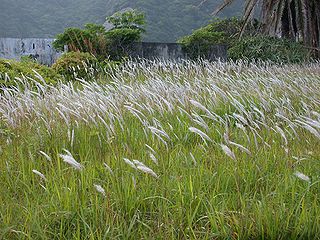
Imperata cylindrica is a species of perennial rhizomatous grass native to tropical and subtropical Asia, Micronesia, Melanesia, Australia, Africa, and Southern Europe. It has also been introduced to Latin America, the Caribbean, and the Southeastern United States. It is a highly flammable pyrophyte, and can spread rapidly by colonizing disturbed areas and encouraging more frequent wildfires.

Holcus mollis, known as creeping soft grass or creeping velvet grass, is a species of flowering plant in the grass family Poaceae. It is native to Europe and north Africa.

Stylophorum diphyllum, commonly called the celandine poppy or wood poppy, is an herbaceous plant in the poppy family (Papaveraceae). It is native to North America, where it is found in the eastern United States and Ontario. Its typical natural habitat is moist forests over calcareous rock, particularly in ravines.

Packera obovata, commonly known as roundleaf ragwort, spoon-leaved ragwort, roundleaf groundsel, or squaw-weed, is an erect perennial herb in the Asteraceae (aster) family native to eastern North America. It was previously called Senecio obovatus. Basal and lower leaves are obovate with toothed margins, while upper leaves are pinnately divided. The ray flowers are yellow and the disk flowers orange-yellow, the inflorescences being held well above the foliage.

Tussock grasses or bunch grasses are a group of grass species in the family Poaceae. They usually grow as singular plants in clumps, tufts, hummocks, or bunches, rather than forming a sod or lawn, in meadows, grasslands, and prairies. As perennial plants, most species live more than one season. Tussock grasses are often found as forage in pastures and ornamental grasses in gardens.
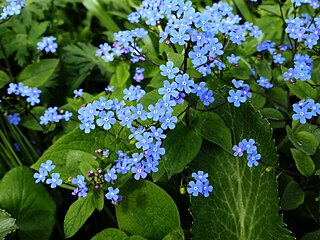
Brunnera is a genus of flowering plants in the family Boraginaceae. They are rhizomatous perennials, native to the woodlands of Eastern Europe and North West Asia. They have hairy leaves and sprays of blue flowers in spring. Numerous cultivars are available, which are valued as groundcover in dappled shade. Some possess variegated foliage. The best known species is Brunnera macrophylla, known as Siberian bugloss.
Limnodea, with the common name Ozark grass, is a genus of North American plants in the grass family. The type species is Greenia arkansanaNutt..
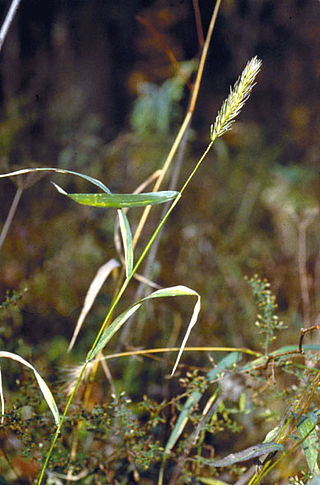
Elymus virginicus, or Virginia wildrye, is a perennial bunchgrass located in Virginia and the eastern United States. Virginia wild rye is one of the few cool season native grasses found in the east Texas area. It is extremely palatable to livestock and will decrease without proper grazing management. It spreads via seed and tillering. It can be confused with Canadian wild rye which is a more robust plant with longer awns. It should be cut early in the season when used for hay to avoid ergot contamination. Northern Missouri Germplasm Virginia wild rye was released in 1999 by the Missouri Plant Material Center for use in northern Missouri.

Diarrhena, or beakgrain, is a genus of Asian and North American plants in the grass family.
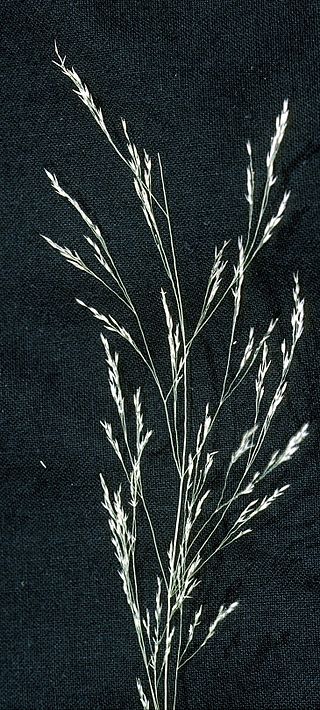
Agrostis perennans, the upland bentgrass, upland bent, or autumn bent, is a species of flowering plant in the grass family, Poaceae.

Puccinellia lemmonii is a species of grass known by the common name Lemmon's alkaligrass. It is native to western North America, particularly the northwestern United States, where it grows in moist, saline soils.
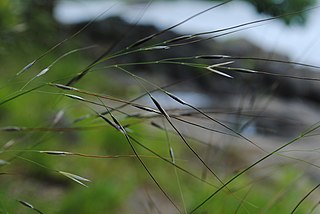
Piptochaetium avenaceum, commonly called black oat grass, blackseed needle grass or blackseed speargrass, is a species of perennial bunchgrass native to eastern North America. It is a member of the grass family Poaceae.
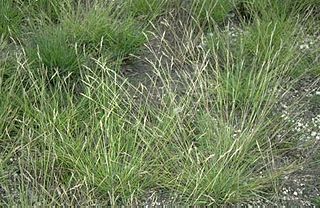
Danthonia spicata is a species of grass known by the common name poverty oatgrass, or simply poverty grass. It is native to North America, where it is widespread and common in many areas. The species is distributed across much of Canada and the United States, and its distribution extends into northern Mexico.

Muhlenbergia capillaris, commonly known as the hairawn muhly, is a perennial sedge-like plant that grows to be about 30–90 cm (0.98–2.95 ft) tall and 60–90 cm (2.0–3.0 ft) wide. The plant includes a double layer; green, leaf-like structures surround the understory, and purple-pink flowers outgrow them from the bottom up. The plant is a warm-season grass, meaning that leaves begin growth in the summer. During the summer, the leaves stay green, but they morph during the fall to produce a more copper color. The seasonal changes also include the flowers, as they grow out during the fall and stay healthy till the end of autumn. The muhly grows along the border of roads and on plain prairies. The grass clumps into herds, causing bush-like establishments in the area the hairawn muhly inhabits. The flowers are very feathery and add a cloudlike appearance to the top of the grass. It is native to eastern North America and can be used for a multitude of purposes, including ornamental gardening and farming. It was voted 2012 plant of the year by the Garden Club of America.

Panicum anceps is a species of grass known by the common name beaked panicgrass. It is native to the southeastern United States, where it occurs as far north as New Jersey and as far west as Kansas and Texas.

Oplismenus hirtellus is a flowering perennial plant from the family Poaceae that can be found on every continent in the world except Antarctica, growing mostly in coastal tropic and subtropic regions as well as tropical and subtropical islands such as Hawaii, New Zealand, Australia and Madagascar.

Oplismenus undulatifolius, commonly known as wavyleaf basketgrass, is a species of perennial grass from the family Poaceae that is native to Eurasia, specifically Southern Europe through Southern Asia. Due to its invasive nature, it can be found in countries such as Pakistan, China, Japan, Korea, India, Australia, South Africa, and has since been introduced to the Mid-Atlantic United States. There are no recognized subspecies in Catalogue of Life.

Sparganium americanum, American bur-reed, is a perennial plant found in the United States of America and Canada. Though this species resembles a grass, it is a type of bur-reed. This species is important for conservation purposes because it has the ability to remove nitrogen and phosphorus runoff from water, like many other wetland species. By doing this it protects waterways from excess nitrogen which can cause eutrophication. This increased nitrogen is especially a problem during the farmers’ growing season. During this same time frame the S. americanum is growing and taking up nitrogen.
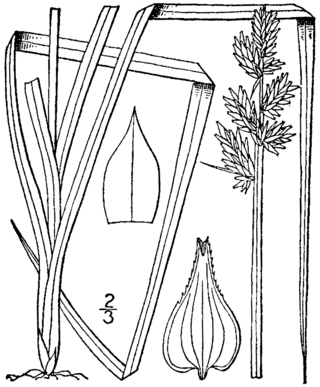
Carex conjuncta, known as soft fox sedge, is a species of sedge that was first formally named by Francis Boott in 1862. It is endemic to the central and eastern United States.




















